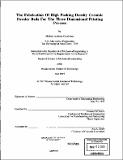The fabrication of high packing density ceramic powder beds for the three dimensional printing process
Author(s)
Caradonna, Michael Anthony
DownloadFull printable version (15.83Mb)
Other Contributors
Massachusetts Institute of Technology. Dept. of Mechanical Engineering.
Advisor
Emanuel M. Sachs.
Terms of use
Metadata
Show full item recordAbstract
Three Dimensional Printing is a solid freeform fabrication process which can be used to create parts directly from CAD models. In the past, the 3DP process has been used to create structural ceramic parts using spray dried powders. Although fully dense parts have been made, it has been necessary to use an iso-static pressing step before sintering. Such a step has many disadvantages such as causing anisotropic shrinkage, warping, and lower part yields. In order to eliminate the iso-static pressing step, an improved process which uses slurries instead of dry powders makes it possible to fabricate green parts with high enough packing density that printed parts can be sintered directly. The main effort on the slurry-based 3DP process focused on fabricating powder beds which had high packing density and good surface finish. Three possible approaches were investigated: repeated tape-casting, spray deposition, and ink-jet printing of slurry. The repeated tape-casting approach was able to produce powder beds with excellent surface finish (4 [mu]m peak-to-peak roughness), high packing density (60-65% of theoretical), and small pore size (typically 0.3 [mu]m or less). Such powder beds can also be fabricated relatively quickly since a layer is produced in a single pass. However, this approach can be difficult to control. The spray deposition approach was determined to be a poor candidate for layer fabrication. Besides having relatively rough surface finish, nozzle performance problems make it impossible to build thick powder beds with good dimensional control. The ink-jet printing approach has produced large powder beds up to 8.5 mm in height. For such powder beds, good surface finish (8 [mu]m local peak-to-peak roughness) and dimensional control was evident. Ink-jet printed powder beds also have good packing density (55-62% of theoretical) and pore size distribution. One problem with powder beds which have been printed is that velocity ripple in the fast-axis shows up as a height ripple on the powder bed surface (typically 4.5% peak-to-peak). This can be eliminated with improved machine design. The ink-jet printing approach appears to be the leading method of fabricating complex ceramic parts with the slurry-based 3DP process.
Description
Thesis (S.M.)--Massachusetts Institute of Technology, Dept. of Mechanical Engineering, 1997. Includes bibliographical references (leaf 123).
Date issued
1997Department
Massachusetts Institute of Technology. Department of Mechanical EngineeringPublisher
Massachusetts Institute of Technology
Keywords
Mechanical Engineering.